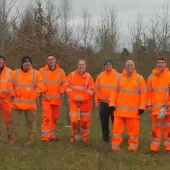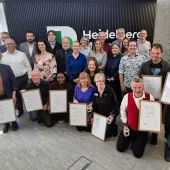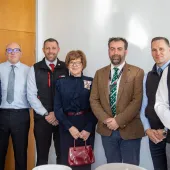Shorncote Quarry Restoration Revisited

First published in the June 2019 issue of Quarry Management as A Wildlife Exemplar
John Salmon of Land & Mineral Management revisits Hills Quarry Products’ Shorncote Quarry in the Cotswold Water Park to see if the beneficial restoration impacts he helped promote many years ago have been achieved
'What is it that makes a restoration scheme outstanding instead of just good?’ I asked Ben Welbourn, biodiversity and estates manager of the Cotswold Water Park Trust. We were on the banks of one of the finest wildlife lakes in Gloucestershire. The spring foliage covering half a dozen inaccessible islands looked splendid.
Hills Quarry Products had invited me to revisit Shorncote Quarry, which straddles the Gloucestershire–Wiltshire border and forms part of the Cotswold Water Park. Quarrying here started in 1988. At the time, I had helped assemble land and mineral rights and supervised working and restoration designs, but I had not been back for many years. I had helped acquire the ‘Thames Water Land’ which we were now looking at. It was then a fallow area used for sewage sludge disposal.
I had returned to see whether the beneficial restoration impacts which I had helped promote years ago had been achieved. What makes Shorncote such a restoration leader and how does nature conservation work around a busy operational quarry?
Many years ago, I remembered watching trial holes being dug through layers of Thames Water’s dried sewage sludge, but now I was looking at an exemplary wildlife site, home to water vole, otter, all types of birds and a vast array of butterflies, dragonflies, damselflies and bats. Mr Welbourn, custodian of all things ecological in the Water Park, was my guide.
Hills Quarry Products are the minerals and ready-mixed concrete arm of The Hills Group, an independent, family business whose other operations include waste management and house building. Shorncote, their flagship sand and gravel quarry is in the upper Thames Valley. The quarry’s linear footprint is large, about 3.75km from north to south and 0.75km from east to west. It takes its name from the adjoining hamlet, known for its church built in 1170 and said to be ‘set in a secluded, peaceful countryside setting’.
The Cotswold Water Park extends over some 40 square miles and has about 150 lakes from a century of gravel extraction. It is still only half exploited with many years of potential extraction still remaining. Shorncote Quarry has produced nine of the lakes so far and has reed beds, willow carr and dryland restoration, including agriculture. Two more lakes are yet to be extracted.
Mr Welbourn explained that although much standing open water has been created, wildlife needs a more nuanced diverse habitat. This can only be achieved by effective dialogue between ecology managers, the mineral operator and the planning authority. It needs commitment and enthusiasm. At Shorncote, the Trust has worked closely with Hills and compliments the company on actually listening and acting on the highly specialist advice which the Trust can offer. That is not always easy for operators. There are so many regulatory bodies, people and politicians who want their voices heard, especially in the early development stages. All must be listened to but it is important for the operator and the planners not to get steamrollered by those who shout loudest.
Mineral operators must engage with the planners but, in this era of budget cuts, counties have been losing their ecological expertise. Shorncote’s five local authorities do not always agree with each other, which is another example of why, in my opinion, mineral working would be better served by a regionally based national planning service. Inexperienced planners seek schemes which are over-manicured or over-developed. The belief that green is good is not necessarily so. Spreading topsoil can turn an old quarry green but of use only for Canada geese, nettles and docks. No topsoil, or a thin veneer, is, as Mr Welbourn explained, good for the operator because there will be less management for greater benefit. The un-manicured, naturally regenerating areas at Shorncote are providing excellent habitat for stonechat, goldfinch, little ringed plover, sand martin, oystercatcher, hobby and lapwing.
Murmurations of starling are now common over the reed beds and old silt lagoons. Reed beds are rarely created except by mineral working and Shorncote’s reed-fringed islands are designed for ground-nesting birds and have attracted bittern and spotted crake. ‘It is’, said Mr Welbourn, ‘highly likely that it will be the first site in the Water Park to host breeding bittern and great white egret.’ The best silt lagoon habitat, I was told, is achieved by not overfilling, because a thinner depth of silt retains moisture better. However, planners often seek smaller instead of more extensive silt areas for visual reasons.
Shorncote Quarry has achieved its restoration excellence by strategic planning on a landscape scale. Working with a long-term vision is essential. A good restoration cannot be achieved by a short-term fix. Planning policy requires an environmental improvement within the red line of every application but it is only now being recognized that an odd copse or pond in the corner of a field is not always effective. It could be better to combine the time, effort and money in large-scale restoration projects elsewhere to reap more worthwhile environmental benefits.
If nature is to be properly conserved a restored site must provide sufficient income to pay for its management. This concept is often hard to sell to planners who look for 100% nature conservation, but without the benefit of a long-term income from other uses, future management will be neglected. Fishing, if managed sensitively, can go hand in hand with conservation and generates revenue. Partial restoration to agriculture could provide a sufficient income.
The Trust promotes leisure on a grand scale. Next to Shorncote Quarry is the Country Park with a popular summer beach offering public swimming, picnicking, kayaking, paddleboarding, fishing and sailing. Good revenues are achieved from quality attractions.
The minerals industry is currently being consulted on the Aggregates Levy. This tax on every tonne of primary aggregate, introduced in 2002 to encourage recycling, has historically brought in between £240 and £410 million to HM Treasury annually but little of the levy goes back to the environment. Grants from Natural England’s Aggregates Levy Sustainability Fund have dried up at Shorncote. However, if the levy is to remain, an opportunity now exists to persuade government, through the consultation process, to use it in the same way that the Landfill Tax Credit Scheme provided grants for environmental and local causes near a landfill site. The environmental gains, local economic benefits and goodwill towards the quarry industry which could be gained by diverting tax from a quarry operator directly to a nature conservation area would have far-reaching beneficial consequences.
We watched the quarry operation, the processing plant and ongoing construction of a new field conveyor to Shorncote’s last phase of working. All this is happening next to a bountiful wildlife site. I asked Ben Welbourn how? The reason, he explained, is simple: ‘People and dogs are excluded from working quarries and wildlife gets used to machinery and ignores it. The plant operatives look out for and are often fiercely protective of the animals.’ He continued: ‘If I could freeze an active quarry in time and have it as a nature reserve that would be absolutely fantastic. At the moment quarries close and others open so wildlife will continue to manage well.’
Ironically, the future ability to continue extracting in the Water Park is threatened by Natural England’s enthusiasm to make the whole park a Site of Special Scientific Interest (SSSI). Paradoxically, the mineral extraction that made the Water Park such a fabulous haven for wildlife could be restricted, or made very much more difficult to achieve, by the designation. Natural England should, it is considered, delay notification until the Park is finished. Then it could even be ripe to designate it a National Park.
Another concern is the Ministry of Defence’s attitude to restoration and bird strike. But, Mr Welbourn explained, advisers to the MoD do not always demonstrate the necessary expert knowledge, and large flocks of geese and swans create a far greater problem on restored agricultural land than on sensitively designed wetland habitats.
It is clear that to restore quality wildlife schemes, industry must have enthusiasm and passion. It must engage with local ecological knowledge from experienced advisers. The interest and commitment of the landowner is needed as well as a willingness of planners and politicians to co-operate rather than dictate. Sufficient money is required but, with a landscape-scale vision, it can be attracted. The potential to use the Aggregates Levy could provide a fantastic boost for environmental schemes, achieving enhanced public access, even climate-change alleviation and carbon storage. The local economy and quality of community life would benefit immensely by properly funded, high-quality, multi-functional landscape. Hills Quarry Products and the Cotswold Water Park are already achieving this together.
- Subscribe to Quarry Management, the monthly journal for the mineral products industry, to read articles before they appear on Agg-Net.com








